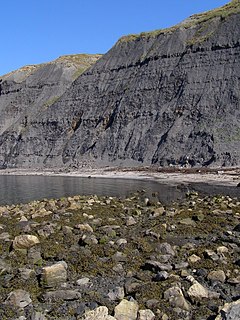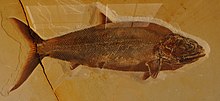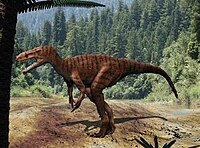Loading AI tools
Geological formation in England From Wikipedia, the free encyclopedia
The Kimmeridge Clay is a sedimentary deposit of fossiliferous marine clay which is of Late Jurassic to lowermost Cretaceous age and occurs in southern and eastern England and in the North Sea.[1] This rock formation is the major source rock for North Sea oil. The fossil fauna of the Kimmeridge Clay includes turtles, crocodiles, sauropods, plesiosaurs, pliosaurs and ichthyosaurs, as well as a number of invertebrate species.
| Kimmeridge Clay | |
|---|---|
| Stratigraphic range: | |
 Grey cliffs of Upper Kimmeridge Clay above the beach at Egmont Bight | |
| Type | Geological formation |
| Unit of | Ancholme Group (onshore), Humber Group (offshore) |
| Sub-units | Birch Sandstone Member Burns Sandstone Member Claymore Sandstone Member Dirk Sandstone Member Magnus Sandstone Member Ptarmigan Sandstone Member Ribble Sandstone Member |
| Underlies | Portland Sand Formation, Speeton Clay Formation, Spilsby Sandstone |
| Overlies | Ampthill Clay, Corallian Group |
| Lithology | |
| Primary | Mudstone |
| Other | Siltstone, Sandstone, Conglomerate |
| Location | |
| Region | England (surface) North Sea (subsurface) |
| Country | United Kingdom |
| Type section | |
| Named for | Kimmeridge Bay |
| Location | Type section - North Sea well 47/15- 1 at 885-919 m depth Type area - coastal outcrops from Black Head, Weymouth to Chapman's Pool |
This section needs expansion. You can help by adding to it. (May 2016) |
Kimmeridge Clay is named after the village of Kimmeridge on the Dorset coast of England, where it is well exposed and forms part of the Jurassic Coast World Heritage Site.[2] Onshore, it is of Late Jurassic (Kimmeridgian) age and outcrops across England, in a band stretching from Dorset in the south-west, north-east to North Yorkshire. Offshore, it extends into the Lower Cretaceous (Berriasian Stage) and it is found throughout the Southern, Central and Northern North Sea.[1]
The foundations of the Humber Bridge on the southern (Barton) side of the bridge are on Kimmeridge Clay beneath superficial deposits, under the Humber estuary.[3]
Kimmeridge Clay is of great economic importance,[2] being the major source rock for oil fields in the North Sea hydrocarbon province.[4] It has distinctive physical properties and log responses.[5]
Color key
|
Notes Uncertain or tentative taxa are in small text; |
Fauna uncovered from the Kimmeridge Clay include:[6]
| Ray-finned fishes of the Kimmeridge clay Formation | ||||||
|---|---|---|---|---|---|---|
| Genus | Species | Location | Stratigraphic Position | Abundance | Notes | Images |
|
Indeterminate |
Dorset |
Most common Kimmeridge clay fish, known from several complete specimens |
Housed at the etches collection, discovered by Steve Etches |
 | ||
|
Indeterminate |
Dorset |
Housed at the etches collection, discovered by Steve Etches |
||||
|
Indeterminate |
Dorset |
Housed at the etches collection, discovered by Steve Etches |
||||
|
Indeterminate |
Dorset |
One specimen, a fin |
Housed at the etches collection, discovered by Steve Etches |
|||
|
Indeterminate |
Dorset |
Housed at the etches collection, discovered by Steve Etches |
||||
|
Indeterminate |
Dorset |
Housed at the etches collection, discovered by Steve Etches |
||||
|
Indeterminate |
Dorset |
Housed at the etches collection, discovered by Steve Etches |
 | |||
|
Indeterminate |
Dorset |
Housed at the etches collection, discovered by Steve Etches |
||||
|
H.tenuirostris |
Dorset |
Rare |
Housed at the etches collection, discovered by Steve Etches |
|||
|
Indeterminate |
Dorset |
Rare |
Housed at the etches collection, discovered by Steve Etches |
|||
|
Indeterminate |
Dorset |
Rare, one complete specimen |
Housed at the etches collection, discovered by Steve Etches |
|||
|
Indeterminate |
Dorset |
Fairly common, multiple near complete specimens. |
Housed at the etches collection, discovered by Steve Etches |
|||
| Lobe-finned fishes of the Kimmeridge clay Formation | ||||||
|---|---|---|---|---|---|---|
| Genus | Species | Location | Stratigraphic Position | Abundance | Notes | Images |
|
Indeterminate |
Dorset |
One specimen, cranial material |
Coelacanth. Housed at the etches collection, discovered by Steve Etches. More than 2 metres long |
|||
| Cartilaginous fishes of the Kimmeridge clay Formation | ||||||
|---|---|---|---|---|---|---|
| Genus | Species | Location | Stratigraphic Position | Abundance | Notes | Images |
|
Indeterminate |
Dorset |
Known from many dorsal spines |
Housed at the etches collection, discovered by Steve Etches |
|||
|
Indeterminate |
Known from many dorsal spines |
Housed at the etches collection, discovered by Steve Etches |
||||
|
Indeterminate |
Known from many dorsal spines, perhaps a complete head |
Housed at the etches collection, discovered by Steve Etches |
||||
|
Indeterminate |
One specimen |
Housed at the etches collection, discovered by Steve Etches |
||||
|
Indeterminate |
Known from a complete specimen, and other isolated remains |
Housed at the etches collection, discovered by Steve Etches |
||||
|
Kimmerobatis[9] |
K. etchesi |
Known from multiple partial skeletons |
A spathobatid ray | |||
| Durnonovariaodus [10] | D. maiseyi | Pectinatites pectinatus ammonite zone | One partial skeleton | A hybodontid | ||
| Turtles of the Kimmeridge clay Formation | ||||||
|---|---|---|---|---|---|---|
| Genus | Species | Location | Stratigraphic Position | Abundance | Notes | Images |
| Craspedochelys | C. passmorei | Swindon | "NHMUK R5871 (holotype), subcomplete shell with associated postcranial remains, including parts of the girdles, the left humerus, and partial cervical vertebrae"[11] | Thalassochelydian sea turtle | ||
| Achelonia | A. formosa | Ely, Cambridgeshire | "CAMSM J29898 to CAMSM J29955 (holotype), a partial, disarticulated skeleton"[11] | Thalassochelydian sea turtle, formerly considered the distinct species "Enaliochelys chelonia"[12] | ||
| Pelobatochelys | P. blakii | Weymouth | Carapace fragments | Thalassochelydian sea turtle | ||
| Plesiochelys[13] | P. etalloni | "basicranium with partial otic chambers and fragment of the right maxilla" | Thalassochelydian sea turtle | |||
| Thalassemys | T. bruntrutana, T. hugii | Isle of Purbeck (bruntrutana), Abingdon, Oxfordshire (hugii) | "A partial carapace and associated limb and girdle elements (NHMUK R8699)" (Purbeck) "A large shell (OUMNH J.66966)" (Oxfordshire)[13] | Thalassochelydian sea turtle | ||
| Tropidemys[13] | P. langii | Weymouth | "NHMUK OR44178b, an isolated neural; NHMUK OR45920, right costals 1–3; NHMUK OR45921, a left first costal; NHMUK R2733, a left fourth costal" | Thalassochelydian sea turtle | ||
| Genus | Species | Location | Member | Abundance | Notes | Images |
|---|---|---|---|---|---|---|
|
B. megarhinus |
A pelagic teleosaurid.[14] |
    | ||||
|
C. gracilis |
||||||
|
D. maximus |
A geosaurine metriorhynchid | |||||
|
M. brevirostris |
A metriorhynchine metriorhynchid | |||||
|
P. manseli |
A geosaurine metriorhynchid | |||||
|
T. carpenteri[15] |
A geosaurine metriorhynchid | |||||
|
T. coryphaeus[17] |
A geosaurine metriorhynchid | |||||
Indeterminate ankylosaur osteoderms have been found in Wiltshire, England.[18] Indeterminate stegosaurid remains have been found in Dorset and Wiltshire, England.[6]
| Genus | Species | Location | Member | Abundance | Notes | Images |
|---|---|---|---|---|---|---|
|
C. prestwichii[6] |
|
"Fragmentary skull and skeleton."[19] |
Iguanodontian |   | ||
|
D. armatus[6] |
vertebrae, a massive right femur (thigh bone), ribs and a near complete pelvis. |
Stegosaur. Wiltshire remains include specimens previously referred to Omosaurus armatus and O. hastiger.[6] | ||||
|
Indeterminate[6] |
|
Kimmeridge clay remains considered to represent a possible close relative of Bugenasaura[20] are now regarded as the remains of an indeterminate euornithopod.[6](The specimen may have had its locality and horizon mislabelled.) | ||||
|
O.armatus[6] |
|
Reclassified as Dacentrurus armatus because the generic name Omosaurus was preoccupied.[6] | ||||
|
O. hastiger[6] |
|
|||||
Indeterminate ornithomimmid remains have been found in Dorset, England.[6] An undescribed theropod genus was found in Dorset.[6]
| Genus | Species | Location | Stratigraphic position | Material | Notes | Images |
|---|---|---|---|---|---|---|
|
B. suffosus[6] |
|
"[Seven] dorsal and sacral centra."[21] |
Considered a nomen dubium. |
 | ||
|
C. humerocristatus[6] |
|
Now Duriatitan.[22] | ||||
|
Indeterminate[6] |
|
Remains previously referred to an indeterminate species of Cetiosaurus are now regarded as indeterminate sauropod material.[6] | ||||
|
D. humerocristatus |
|
|||||
|
G. megalonyx[6] |
|
Remains previously referred to Gigantosaurus megalonyx are now regarded as indeterminate sauropod material.[6] | ||||
|
"Humerus."[24] |
Remains previously referred to Ischyrosaurus manseli are now regarded as indeterminate sauropod material.[6] | ||||
|
J. langhami |
|
Partial skeleton |
A primitive tyrannosaur | |||
| Torvosaurus[27] | Indeterminate |
|
Tibia (OUMNH J.29886) and maxilla fragment, collected separately | A megalosaurid | ||
|
Indeterminate |
A tooth from Foxhangers, Wiltshire (NHMUK 46388), phalanges from an unspecified locality in Wiltshire (DZSWS 3009), and a proximal caudal vertebra from Shotover, Oxfordshire (OUMNH J.47134).[27] |
Remains previously referred to Megalosaurus are now regarded as indeterminate theropod material.[6] | ||||
|
Indeterminate[6] |
Remains previously attributed to one or more indeterminate species of Ornithopsis (incl. O. leedsii) are now regarded as possible indeterminate sauropod material.[6] | |||||
| Genus | Species | location | Material | Notes | Images |
|---|---|---|---|---|---|
| Cuspicephalus[28] | C. scarfi |
Dorset |
Partial Skull | Missing Crest, lower jaw and dentition |
  |
|
R.etchesi |
Dorset |
||||
|
indeterminate[29] |
Abingdon, Oxfordshire |
Left first wing finger phalanx | |||
|
indeterminate |
Dorset |
||||
| Genus | Species | Location | Member | Abundance | Notes | Images |
|---|---|---|---|---|---|---|
|
B. swindoniensis |
Plesiosaur of unknown affinities |
  | ||||
|
C. megadeirus |
||||||
|
C. trochantericus |
Nomen dubium | |||||
|
K. langhami |
A cryptoclidid | |||||
|
"P." manseli |
Distinct from Colymbosaurus.[30] | |||||
|
P. brachydeirus |
||||||
|
P. brachyspondylus[31] |
Nomen dubium | |||||
|
P. carpenteri |
A thalassophonean pliosaurid | |||||
|
P. kevani |
A thalassophonean pliosaurid | |||||
|
P. portentificus[33] |
A nomen dubium | |||||
|
P. ?rossicus |
A thalassophonean pliosaurid; taxonomic identification of specimens tentative[31] | |||||
|
P. westburyensis |
A thalassophonean pliosaurid | |||||
|
P. sp. 1 |
Partial skeleton, CAMSM J.35991 |
A thalassophonean pliosaurid; previously assigned to the nomen dubium P. brachyspondylus[31][32] | ||||
|
P. sp. 2 |
Mandible, NHMUK PV OR 39362 |
A thalassophonean pliosaurid; previously assigned to the nomen dubium P. macromerus[31][32] | ||||
|
Indeterminate |
||||||
| Genus | Species | Location | Stratigraphic Position | Abundance | Notes | Images |
|---|---|---|---|---|---|---|
|
B.extremus |
Dorset |
     | ||||
|
G.mordax |
Dorset |
|||||
|
Indeterminate |
Dorset |
Giant, near complete specimen. Proposed to have been 6 metres long when complete. Housed at the Etches collection in dorset. | ||||
|
M.trigonus |
Dorset |
Nomen dubium - classified by a single vertebra | ||||
|
N.enthekiodon |
Dorset |
|||||
|
T. etchesi |
Dorset |
The Pectinatites pectinatus ammonite zone |
||||
|
Indeterminate |
Dorset |
|||||

The invertebrate fauna of the Kimmeridge Clay includes:[34][35]
Seamless Wikipedia browsing. On steroids.
Every time you click a link to Wikipedia, Wiktionary or Wikiquote in your browser's search results, it will show the modern Wikiwand interface.
Wikiwand extension is a five stars, simple, with minimum permission required to keep your browsing private, safe and transparent.